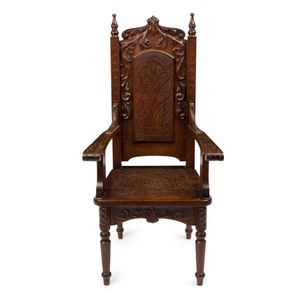French Salon Chair with Petit Point Upholstery
You must be a subscriber, and be logged in to view price and dealer details.
Subscribe Now to view actual auction price for this item
When you subscribe, you have the option of setting the currency in which to display prices to $Au, $US, $NZ or Stg.
- Rail - A term used by cabinet makers for the horizontal sections of the frame of an item such as a chair or settee which have a front rail, a back rail and two side rails, and also on a door or carcase, where the rails are joined to the vertical framings.
- Petit Point - Petit point embroidery is a type of needlework that is characterized by small, delicate stitches worked onto a fine canvas or mesh fabric. The stitches used in petit point embroidery are typically very small and precise, and are worked in diagonal rows to create a smooth, even surface.
Petit point embroidery is often used to create intricate designs and patterns, such as floral motifs, landscapes, and portraits. The embroidery can be done in a variety of colours and can be quite detailed and realistic.
The technique of petit point embroidery has been used for centuries in various forms of decorative art, including tapestries, cushions, and clothing. It was particularly popular in the 17th and 18th centuries in Europe, where it was used to create elaborate wall hangings and furniture coverings.
Petit point embroidery is still practiced by many artisans and is used to create a wide range of decorative items, including jewellery, handbags, and home decor. The technique requires patience and skill, as the small stitches can be time-consuming to work and require a steady hand. - Fluting - A form of decoration found on many pieces of furniture, as well as ceramics, silver and clocks, in which round-bottomed grooves, of varying width and depth, are let into columns, pilasters, legs. As a general rule, flutes are cut in the vertical, though they may follow a turned leg in a spiral pattern. In cross-section, they may be described as a series of 'U' shapes, rising and narrowing at each end of the groove. Fluting is the opposite of reeding, with which fluting is often associated.
This item has been included into following indexes:
-
chairs, singles / pairs / threes, style or period
- French 949
- salon 79
- Victorian, other styles 1,179
Visually similar items

A 17th century English oak joined armchair with a diamond panelled back below a concave nulled frieze, above scroll arms and turned legs with cross stretchers, initialled Eb to apron and Js to back, right arm loose.

A set of eight Louis XIII style leather and oak chairs, late 19th to early 20th century, the square back chairs with shell form finials, leather back rests embossed with a trailing vine and grape motif above a series of spindles to the mid-rail, the side s

School of Robert Prenzel carver chair, blackwood, early 20th century decorated with carved orchids monogram and dated 'E.Y.C. 6th Sept. 1904' 53 cm across the handles

A Georgian oak settle, circa 1780. 110 cm high, 182 cm wide, 70 cm deep
